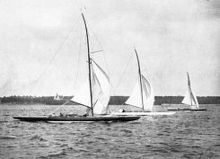98:, neither of which were seen as fully satisfactory by the Swedish Sailing Federation. The committee completed its proposal the following year. It was accepted as the first Square Metre Rule: yachts were to be classed by their sail area which was fixed. In addition, there were minimum requirements for weight and cabin measurements. Four new classes were originally accepted: 22 m, 30 m, 45 m and 55 m. Soon, new classes were to follow: the 38 m class in 1912; 15 m, 75 m, 95 m, 120 m and 150 m classes in 1913; finally in 1915, the 38 m and 45 m classes were combined into a new 40 m class. The new rule became very popular within the Baltic region; between 1907 and 1920, Finnish yards alone built some 600 Square metre rule yachts. During peak years, Skerry cruisers made up 95 percent of the yards' output. They were also exported to other European countries and the United States.
31:
173:
22 m and 30 m. Larger classes are mostly boats built prior to the 1925 rule and generally only found in the Baltic, where they are dutifully cared for by enthusiasts. Although it was never quite as widespread as the
International Rule, the Square Metre rule has a devoted following in many countries. Strongholds of the rule have traditionally been Sweden, Finland and Germany, which also had national Square Metre rule boats, known as
165:
107:
78:
135:
soon came up with very extreme designs which pushed contemporary sailboat technology to its limits. Development was dramatic: for example, whilst early 40 m boats tended to be around 9 to 10 metres long, in 1923 Westin designed a 40 m boat which was 15.2 metres long and had a beam of only
126:
The Square Metre rule was much less restrictive than competing
International Rules. The relatively loose set of rules allowed previously built boats into the new classes if their rigging was modified to comply with the rules. They also gave designers relatively free hand, and top designers like the
155:
As weaknesses of the original rule became apparent, the
Swedish Sailing Federation enacted a number of modifications from 1916 onwards. Construction standards became much more strict and classes had minimum freeboard and maximum lengths defined. The Rule also specified new minimum measurements for
172:
As with many other sailing handicap and construction rules, the Square Metre rule fell in popularity as its weaknesses were discovered. However, in its revised form it has proved to be enduring and new boats following the rule are still built today. The internationally most active classes are the
89:
established a committee to design a national racing yacht class. Previous handicap rules had tended to be very simple and boats had evolved to be very fast and extreme racing machines, which were perceived as unsafe and impractical. Recently developed other options were the
156:
internal space, to ensure that boats would have adequate room for accommodations. This is in contrast to
International Rule designs where cabins are not required. The final revision of the rule was issued in 1925. It is still in effect with only minor later changes.
152:, but only a handful of boats participated. Meanwhile, International Rule had been revised in 1919 and in their new form became very popular, soon supplanting the Square Metre rule boats in the international arena and Olympic regattas.
147:
This development quickly led to diminishing popularity of the Square Metre rule as these extreme hulls were perceived simply as too weak and uncomfortable to ride. 30 m and 40 m classes were accepted to the
227:). The Swedish word "kryssare" has a slightly different and broader meaning than the English term "cruiser" and as such, the English translation is somewhat misleading.
342:
188:
and construction classes, which usually were an attempt to design a cheaper alternative to high-end yachts. These include
Swedish Mälar boats (M15,
132:
136:
1.74 m — a length to beam ratio of nearly 9 to 1. An often cited example as some sort of pinnacle of the rule was the 150 m
64:, making them broadly comparable in size and performance. Most skerry cruisers are slender boats, with low freeboards and tall rigs.
144:
had the dubious pleasure of surfing this boat at 14 knots and claimed afterward that it followed the waves "like a sea serpent".
17:
335:
315:
666:
149:
278:
661:
328:
56:, though some classes also saw popularity in other European countries and the United States. Skerry cruisers are
493:
200:), Finnish Nordic 22, 'B' class Skerry cruisers and others. Some other early one-design classes, such as the
563:
236:
204:
show obvious Skerry cruiser influence. Swede 55 and Swede 41 yachts were also based on Square Metre boats.
77:
60:, meaning that though the boats are not identical with each other, they are all built according to same
86:
538:
264:
656:
651:
351:
95:
528:
8:
498:
140:, designed by Estlander in 1919 and claimed to have been the fastest boat in the Baltic:
583:
578:
553:
543:
518:
119:
523:
311:
513:
220:
128:
115:
177:. Many German square metre boats were confiscated by the British during and after
30:
573:
503:
282:
212:
458:
453:
395:
246:
201:
91:
645:
630:
568:
533:
380:
375:
370:
400:
385:
365:
275:
178:
320:
181:
and transferred to
Britain, where they became known as 'Windfall' yachts.
296:
197:
193:
189:
614:
593:
558:
302:
Svenska Skärgårdskryssare Förbundet - Swedish Skerry
Cruiser Federation
185:
53:
52:. Originating from Sweden, they were historically most popular in the
468:
463:
423:
306:
241:
609:
478:
448:
443:
405:
164:
141:
508:
473:
438:
433:
428:
106:
61:
265:
http://www.puuvene.net/saaristoristeilijat/Docs/lorelei_saga.pdf
184:
In addition, the Square Metre rule produced a number of related
548:
390:
45:
424:
Ton classes (0–½, ½–1, 1–2, 2–3, 3–10, 10–20, 20 & Open)
588:
48:, usually wooden, which are constructed according to the
301:
207:
The term "skerry cruiser" comes from the
Swedish term
81:
40 m Skerry cruisers at the 1920 Summer
Olympics.
643:
336:
350:
343:
329:
163:
105:
76:
29:
14:
644:
101:
94:(also called 'American rule') and the
324:
24:
25:
678:
290:
307:Skerry Cruisers of North America
269:
258:
13:
1:
494:French National Monotype 1924
252:
297:Outline of Square Metre Rule
237:International rule (sailing)
7:
667:Development sailing classes
230:
10:
683:
110:150 m Skerry cruiser
87:Swedish Sailing Federation
72:
67:
623:
602:
414:
358:
159:
489:Skerry cruiser 40 m
484:Skerry cruiser 30 m
281:October 6, 2007, at the
168:22 m Skerry cruiser
96:International Metre rule
662:Olympic sailing classes
417:(In order of first use)
352:Olympic sailing classes
224:
216:
169:
123:
82:
34:
167:
109:
80:
33:
624:Former youth classes
150:1920 Summer Olympics
58:construction classes
18:150m² Skerry cruiser
102:Decline and rebirth
42:Square metre yachts
579:Mistral One Design
225:saaristoristeilijä
170:
124:
83:
35:
639:
638:
534:12 m Sharpie
316:978-90-78440-23-9
209:skärgårdskryssare
50:Square metre rule
16:(Redirected from
674:
345:
338:
331:
322:
321:
285:
273:
267:
262:
129:Gustaf Estlander
116:Gustaf Estlander
21:
682:
681:
677:
676:
675:
673:
672:
671:
642:
641:
640:
635:
619:
598:
539:Flying Dutchman
416:
410:
359:Current classes
354:
349:
293:
288:
283:Wayback Machine
274:
270:
263:
259:
255:
233:
175:Seefahrtkreuzer
162:
120:Kanholmsfjärden
104:
75:
70:
38:Skerry cruisers
28:
23:
22:
15:
12:
11:
5:
680:
670:
669:
664:
659:
657:Sailing yachts
654:
652:Skerry cruiser
637:
636:
634:
633:
627:
625:
621:
620:
618:
617:
612:
606:
604:
600:
599:
597:
596:
591:
586:
581:
576:
571:
566:
561:
556:
551:
546:
541:
536:
531:
526:
521:
516:
511:
506:
501:
496:
491:
486:
481:
476:
471:
466:
461:
459:18 foot dinghy
456:
454:12 foot dinghy
451:
446:
441:
436:
431:
426:
420:
418:
415:Former classes
412:
411:
409:
408:
403:
398:
393:
388:
383:
378:
373:
368:
362:
360:
356:
355:
348:
347:
340:
333:
325:
319:
318:
309:
304:
299:
292:
291:External links
289:
287:
286:
268:
256:
254:
251:
250:
249:
247:Universal rule
244:
239:
232:
229:
217:Schärenkreuzer
161:
158:
114:, designed by
103:
100:
92:Universal rule
74:
71:
69:
66:
26:
9:
6:
4:
3:
2:
679:
668:
665:
663:
660:
658:
655:
653:
650:
649:
647:
632:
629:
628:
626:
622:
616:
613:
611:
608:
607:
605:
603:Youth classes
601:
595:
592:
590:
587:
585:
582:
580:
577:
575:
572:
570:
569:Lechner A-390
567:
565:
562:
560:
557:
555:
552:
550:
547:
545:
542:
540:
537:
535:
532:
530:
527:
525:
522:
520:
517:
515:
512:
510:
507:
505:
502:
500:
497:
495:
492:
490:
487:
485:
482:
480:
477:
475:
472:
470:
467:
465:
462:
460:
457:
455:
452:
450:
447:
445:
442:
440:
437:
435:
432:
430:
427:
425:
422:
421:
419:
413:
407:
404:
402:
399:
397:
394:
392:
389:
387:
384:
382:
379:
377:
374:
372:
369:
367:
364:
363:
361:
357:
353:
346:
341:
339:
334:
332:
327:
326:
323:
317:
313:
310:
308:
305:
303:
300:
298:
295:
294:
284:
280:
277:
272:
266:
261:
257:
248:
245:
243:
240:
238:
235:
234:
228:
226:
222:
218:
214:
210:
205:
203:
199:
195:
191:
187:
182:
180:
176:
166:
157:
153:
151:
145:
143:
139:
134:
130:
121:
117:
113:
108:
99:
97:
93:
88:
85:In 1907, the
79:
65:
63:
59:
55:
51:
47:
43:
39:
32:
19:
488:
483:
401:Laser Radial
386:Formula Kite
271:
260:
208:
206:
183:
179:World War II
174:
171:
154:
146:
137:
125:
111:
84:
57:
49:
41:
37:
36:
564:Division II
133:Zake Westin
646:Categories
615:Techno 293
594:Elliott 6m
559:Windglider
253:References
186:one-design
54:Baltic Sea
529:5.5 Metre
469:8.5 Metre
464:6.5 Metre
242:Ton class
138:Singoalla
112:Singoalla
27:Ship type
610:Nacra 15
499:Snowbird
479:15 Metre
449:10 Metre
444:12 Metre
406:Nacra 17
279:Archived
231:See also
142:Uffa Fox
122:in 1922.
584:Yngling
554:Tornado
544:Tempest
519:Swallow
514:Firefly
509:O-Jolle
474:9 Metre
439:8 Metre
434:7 Metre
429:6 Metre
276:classes
221:Finnish
73:Origins
68:History
62:formula
574:Europe
549:Soling
524:Dragon
391:IQFoil
376:49erFX
314:
213:German
160:Legacy
127:Finns
46:yachts
44:) are
396:Laser
118:, on
631:Byte
589:RS:X
504:Star
381:Finn
371:49er
312:ISBN
196:and
131:and
40:(or
366:470
219:, (
202:Hai
198:M30
194:M25
190:M22
648::
223::
215::
192:,
344:e
337:t
330:v
211:(
20:)
Text is available under the Creative Commons Attribution-ShareAlike License. Additional terms may apply.



